Wondering if a beagle might be the purr-fect match for your whiskered companion? Let me share the tail-wagging tale of Buddy, the beagle, and Whiskers, the tabby cat, who became the epitome of an unlikely friendship. Initially, Buddy's nose was all for the chase, and Whiskers was the reluctant mouse in their playful game. But with understanding, patience, and treats aplenty, these two went from wary roommates to inseparable pals, napping and frolicking together. Their story is not just adorable but a testament to the beagle's adaptable nature and potential for forming deep bonds with feline friends. So, buckle up and let's dive into the dynamics of beagle and cat camaraderie, and how you too can nurture a bond just like Buddy and Whiskers!
Key Takeaways
- Beagles, known for their friendly demeanor, can get along with cats if their natural hunting instincts are managed correctly. Proper introductions and consistent training are crucial to prevent unwanted chasing behaviors.
-
Successfully introducing a beagle to a cat involves carefully managed interactions. Start with scent familiarity to ease initial tension, use leashed introductions to maintain control, and ensure each pet has its own personal space.
-
Patience, consistency in training, and close supervision during early interactions are essential for fostering a peaceful coexistence and building a friendship between a beagle and a cat in a multi-pet home. These steps will help create a harmonious environment for both pets.
Find out how to train your beagle to be the well-behaved pup you desire – Read Free Report
The Beagle's Temperament: A Good Fit for Feline Companionship?
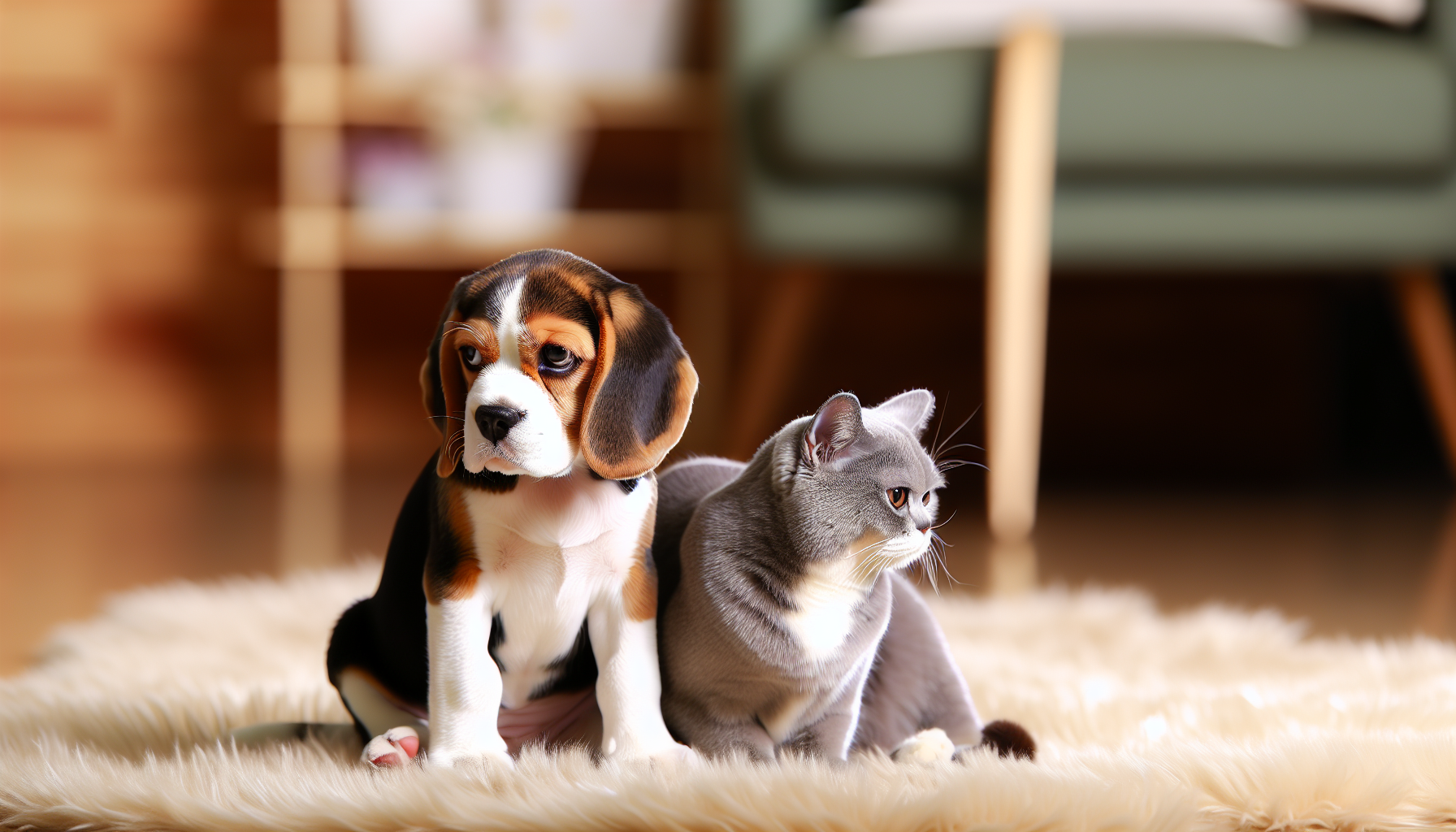
Image created using AI
Beagles have an inherently friendly and affectionate temperament, whether it’s a grown beagle or a beagle puppy. Being pack animals, they thrive on sociability and good-natured playfulness. This makes them one of the best dog breeds to consider as companions for cats. However, keep in mind that beagles, originally bred as a dog breed for hunting dogs, have a natural instinct to chase smaller animals. This instinct is not insurmountable, but it does require proper management and training.
A beagle’s personality can influence its ability to get along with cats. If a beagle has a strong prey drive, it might view cats as small game to chase after, especially if the cat starts running. This means more obedience training and socializing may be necessary to help the beagle view cats as friends, not prey. But with the right approach, most beagles can coexist peacefully with cats and other pets.
Bear in mind that not all beagles are identical. Just like humans, each individual beagle has its own unique traits and temperament. Some beagles might naturally get along well with cats, while others like the Cavalier King Charles Spaniels breed may need more time and positive reinforcement training to build a positive relationship. The key lies in understanding your beagle’s personality and tempering their hunting instincts with proper introductions and training.
Understanding Beagle-Cat Dynamics
Navigating the relationship between your beagle and cat is crucial for a peaceful multi-pet household. Training is key in teaching beagles to peacefully coexist with cats, using positive reinforcement to encourage calm behavior. It's vital to supervise their early interactions closely since beagles have an inherent instinct to chase smaller animals, including cats.
Here are some effective strategies to manage their interactions:
- Gradual Introduction: Introduce your beagle to your cat slowly and in a controlled setting to prevent overwhelming them.
- Positive Reinforcement: Consistently reward your beagle for calm behavior around the cat to reinforce that such behavior is desirable.
- Separate Spaces: Ensure each pet has their own space to retreat to when they feel stressed or need solitude.
- Continuous Supervision: Keep a close eye on interactions until you're confident that both pets can share the space without issues.
Understanding the personality and prey drive of your beagle is crucial. Beagles with a high prey drive may see a running cat as something to chase, which can lead to potential conflicts. Tailoring training and socialization to curb these instincts is necessary for fostering peaceful interactions.
Providing personal space for both pets is essential, as is recognizing that beagles, who are naturally sociable and adaptable, can learn to view cats as part of their pack rather than as prey. With thoughtful training and careful introduction, beagles and cats can coexist harmoniously. By being patient and consistent with these practices, you can help your pets develop a friendly and supportive relationship.
Preparing Your Beagle for a New Cat
Before bringing a new cat into your home, you should adequately prepare your beagle. Obedience training, including teaching beagle basic obedience commands, is key. This preparation helps your beagle follow commands and stay calm when meeting the cat for the first time, setting the stage for a safe and harmonious interaction.
Regulating your beagle’s hunting instincts is fundamental for a serene coexistence with the new cat. Training and socialization can redirect these instincts, ensuring both pets are safe. It’s also important to keep the beagle away from the cat’s litter box, as cat poop can be harmful to them.
Exercise is another important aspect of preparing your beagle for a new cat. A well-exercised beagle is more likely to be relaxed and less likely to act too excited or chase after a new cat. Regular exercise helps them use up their extra energy, making them more manageable during the introduction process.
Essential Tips for Introducing Beagles to Cats
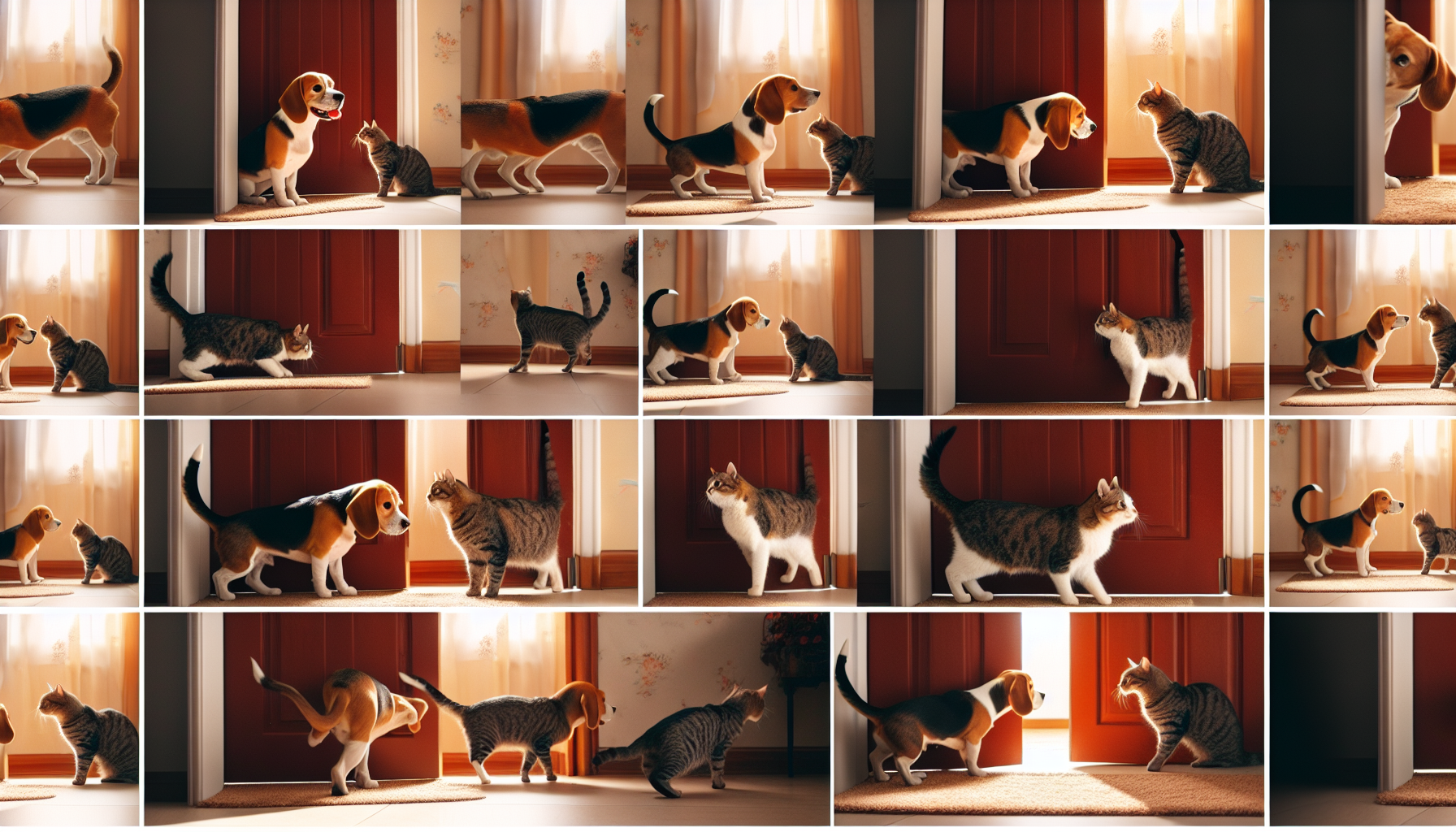
Image created using AI
Introducing beagles to cats requires patience, a methodical approach, and a series of deliberate steps to ensure a successful interaction for everyone involved. These steps include establishing scent familiarity, managing first impressions, and nurturing positive relationships.
Establishing Scent Familiarity
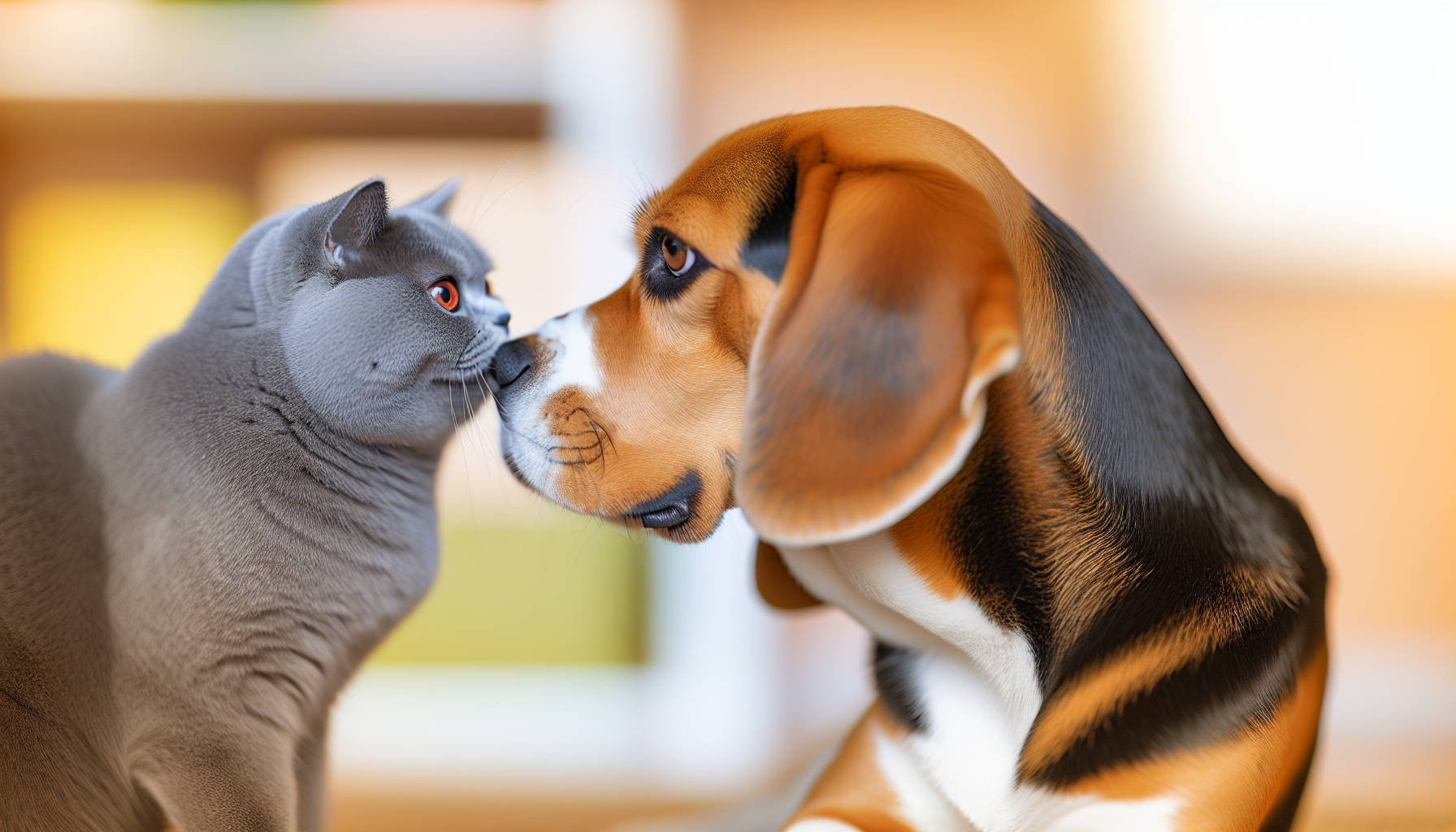
Image created using AI
Creating scent familiarity between your beagle and cat is an essential initial step in the introduction of these two pets. It helps them to be more at ease with each other before they meet face-to-face, helping to prevent any aggressive or chasing behavior that might be triggered by the cat’s scent.
They have an amazing sense of smell, with at least 225 million olfactory receptors, which lets them pick up scents at least 10,000 times better than humans. This strong sense of smell can make a beagle react to the scent of a cat, as it can trigger their hunting instinct, affecting how they behave around the cat.
To help your beagle and cat acclimate to each other’s scents, you can:
- Allow them to spend time with each other’s blankets or toys
- Feed them on either side of a closed door, so they associate the scent with positive experiences like feeding them together.
- Eventually, they can be in the same room together without any issues.
Managing First Impressions
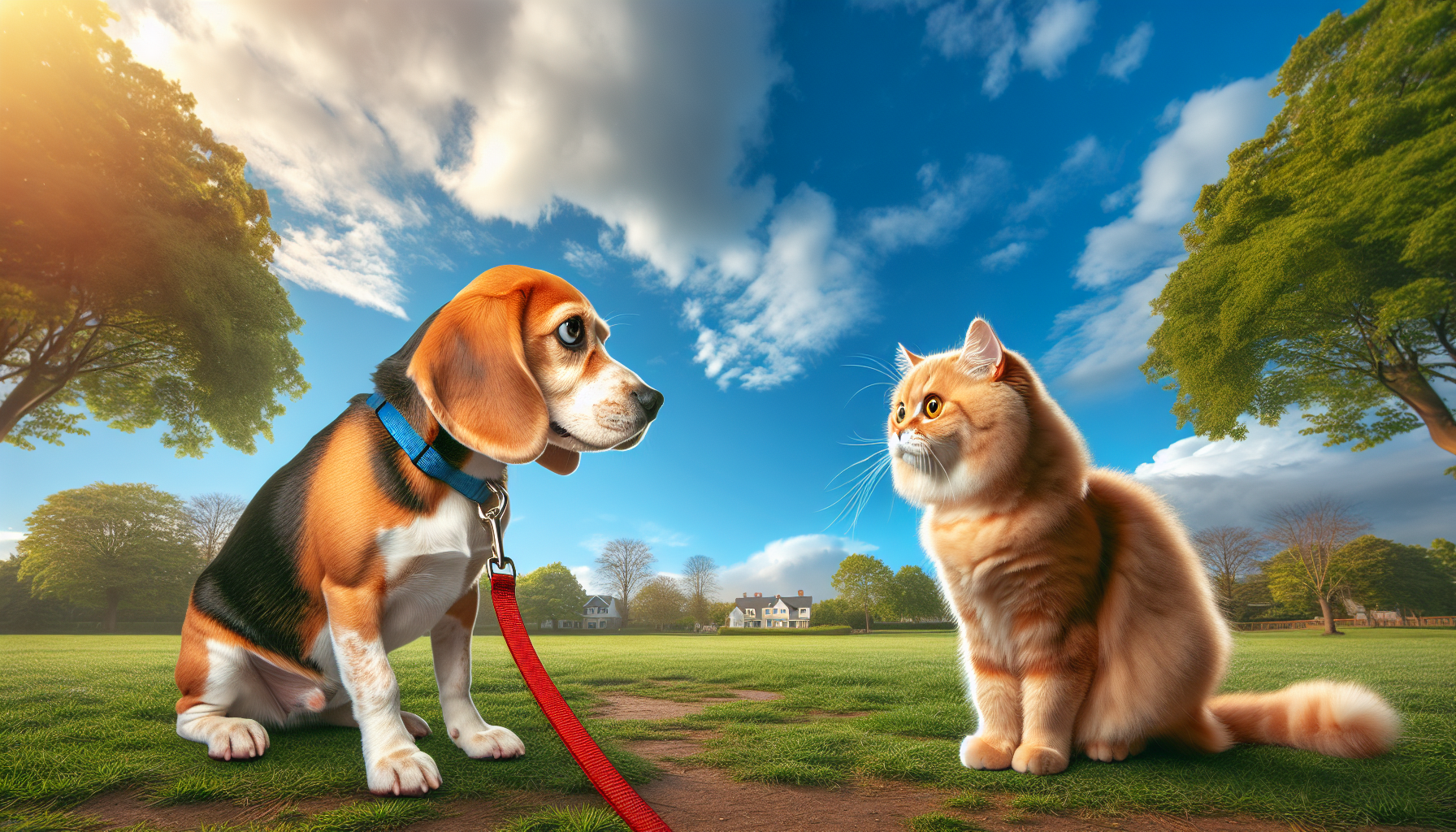
Image created using AI
Controlling first impressions is key when presenting your beagle to your cat. This should be done in a controlled environment where both animals feel safe. The beagle should be leashed and under control, and the area should provide the cat some vertical space to perch up high.
Keeping your beagle on a leash during the first meeting ensures a safe exposure. The leash gives you the ability to move the dog away if the interaction gets too intense or if the dog shows any unwanted behavior towards the cat.
To ensure the safety of your cat, follow these steps:
- Make sure there’s a high escape route that the beagle can’t reach. This helps the cat retreat if it feels threatened or pressured.
- Remember, never force the two animals to interact. Allow them to approach each other at their own pace.
- Use positive reinforcement to encourage calm and friendly behavior.
Building Positive Relationships
Developing a positive relationship between your beagle and cat demands consistent, patient efforts and the use of positive reinforcement. Encourage them to interact at their leisure while providing separate spaces for each to retreat to.
It is vital to supervise their interactions closely during the initial phases to intervene if necessary, preventing any aggressive behavior or mishaps. Signs of a developing friendship might include the beagle dog showing interest in the cat without agitation or peacefully coexisting in the same room. As their interactions grow more calm and consistent, it becomes evident that they are learning to get along.
Creating a Multi-Pet Household Harmony
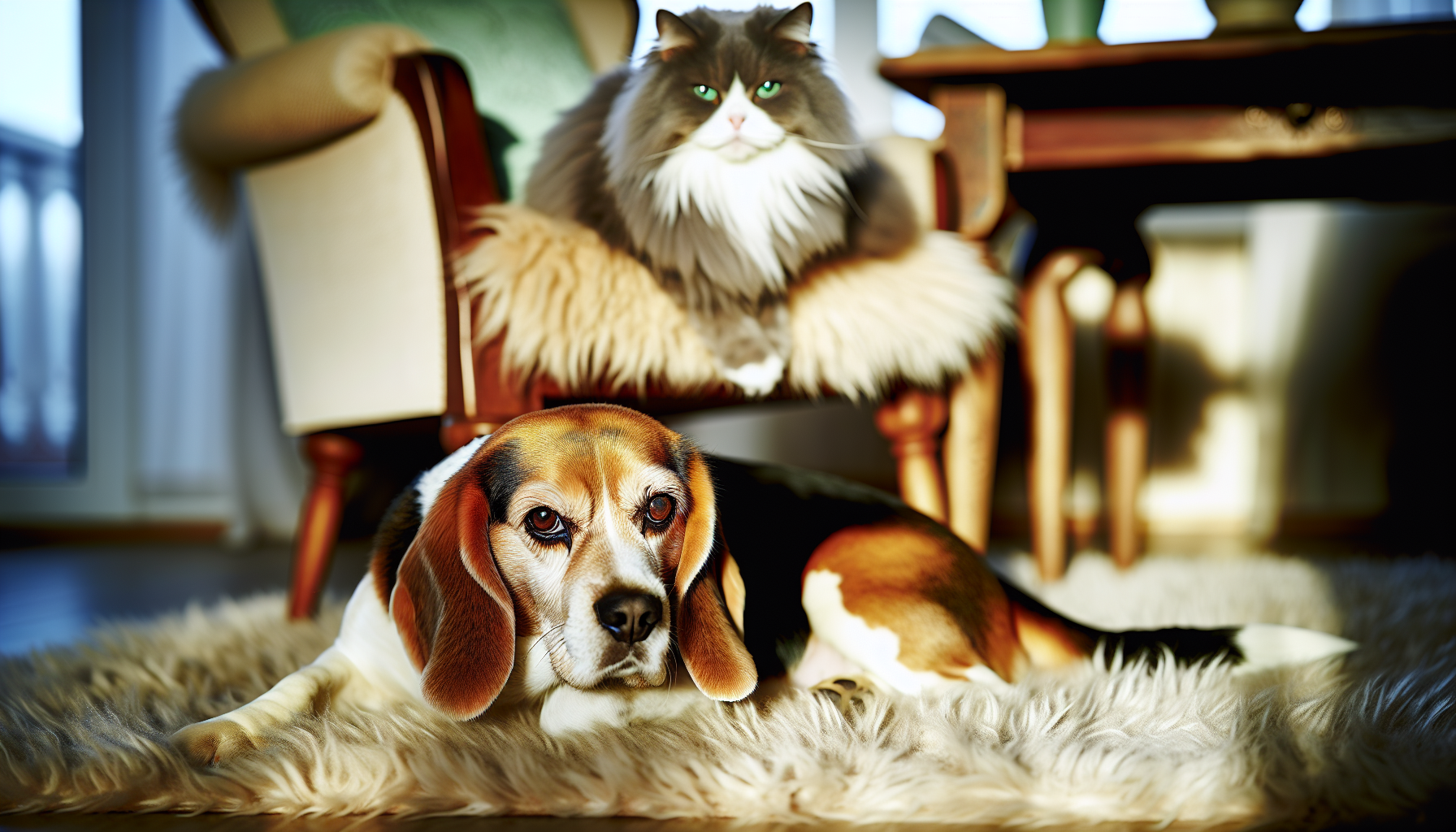
Image created using AI
Fostering harmony in a family cat and multi-pet household necessitates establishing boundaries, ensuring escape routes for cats, and engaging the entire family in the introduction process. By establishing these boundaries, you can manage the beagle’s hunting instincts and the cat’s territorial nature.
Escape routes are crucial for cats in a multi-pet household. They provide a safe space for the cat to retreat to when they feel threatened or just need a break from the beagle’s company.
Getting everyone in the family on board with introducing the pets helps create a peaceful environment for both the beagle and the cat. Everyone should understand the rules and what’s expected of the pets, which helps ensure consistency in training and handling the pets.
Addressing Common Concerns When Beagles Meet Cats
Despite careful preparation and training, you may still face typical issues when introducing your beagle to your cat. These issues can include aggression, excessive barking, and the risk of injury, often referred to in the hunting world as “beagling.” Though it might be a milder form of hunting behavior, it requires attention and management.
Here are some strategies to address these concerns:
Aggression:
If your beagle shows aggression towards the cat:
- Immediately separate them to prevent escalation.
- Reinforce positive behavior when your beagle acts calmly around the cat.
- If aggression persists, consider consulting a professional dog trainer for targeted behavior modification.
Chasing:
If your beagle starts to chase the cat:
- Intervene right away to prevent stress or injury to the cat.
- Ensure the cat has access to safe, high places where the beagle cannot reach.
- Professional training may also be beneficial to address and correct the chasing behavior.
Rough Play:
Beagles can sometimes play too vigorously with cats, which could lead to injuries. To minimize this risk:
- Monitor both pets closely during their interactions, especially during playtime.
- Ensure that their play remains controlled and stops before getting too rough.
- Constant supervision is crucial to promptly address any signs of roughness or potential conflicts.
By following these tips, you can help foster a safer and more respectful environment for both your beagle and cat.
Celebrating Successful Beagle and Cat Friendships
Once your beagle and cat have established a positive relationship, it's time to celebrate their friendship! Successful interactions between beagles and cats exemplify the benefits of patience, careful introductions, and consistent training.
There are countless heartwarming tales of beagles and cats who have become inseparable companions. For example, there's the story of a beagle who bonded deeply with a newly adopted kitten, illustrating the profound connection that can develop. Another inspiring story involves Chloe and Chlea, a beagle and a cat whose friendship showcases the remarkable harmony that these two species can achieve.
While it typically takes about one to two weeks for a beagle and cat to form a significant bond, this timeline can vary greatly depending on the individual animals. With continued patience, dedication, and affection, your beagle and cat have the potential to develop a lasting and enriching friendship.
Summary
Despite the beagle's innate hunting instincts, it is indeed possible for beagles and cats to live together harmoniously. The success of such a relationship heavily relies on correct initial introductions, ongoing training, and careful management of their early interactions. It's important to maintain patience throughout the process, as each animal has its unique personality and rate of adaptation. Celebrating each small success can foster a positive environment as they progress toward a strong, friendly bond. With commitment and the right strategies, your home can happily accommodate both your feline and canine companions.
Frequently Asked Questions
How do you introduce a Beagle to a cat?
To introduce a Beagle to a cat, start by introducing them through scent and sound, then gradually let them see each other, and finally let them meet face-to-face while removing all barriers. This process allows them to bond in a safe and controlled manner.
Will a Beagle chase a cat?
Yes, beagles may chase cats due to their strong hunting instinct, but with training and socialization, this behavior can be managed effectively. Supervision and positive reinforcement are essential in shaping their behavior.
What are the disadvantages of owning a Beagle?
Owning a Beagle has some disadvantages. They can be loud barkers, love to dig, and tend to be stubborn. This might not be the best fit for everyone.
Are beagles good with cats?
Yes, with proper introductions and training, beagles can peacefully coexist with cats.
How long does it take for a beagle and cat to become friends?
It usually takes about one to two weeks for a beagle and cat to form a strong bond, but keep in mind that every pair is unique and the bonding process can vary.
Learn how to train your beagle to be the well adjusted dog you desire –> Access our Free Report
Shop for beagle-themed products and gifts that beagle enthusiasts will love.

